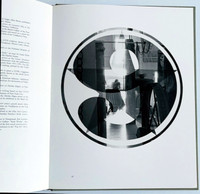
An Educated Collector is Our Best Client
In business for nearly two decades, we are a well established, popular contemporary art boutique specializing in expertly chosen, blue chip prints, multiples, uniques, books, ephemera and merchandise at different price points, with a focus on the secondary market. Please click on the "Contact Us" button at the bottom of this page for questions about any work, pricing and/or to arrange to visit our showroom/gallery - located in between Manhattan's Flatiron and Chelsea Flower Districts.
ALPHA 137 GALLERY
ALPHA 137 GALLERY
Robert Indiana, Deluxe Limited Edition with Slipcase: Robert Indiana Early Sculpture 1960-1962 (Hand signed and inscribed with heart drawing by Robert Indiana ), 1991
CONTACT GALLERY FOR PRICE
Description
Robert Indiana
Deluxe Limited Edition with Slipcase: Robert Indiana Early Sculpture 1960-1962 (Hand signed and inscribed with heart drawing by Robert Indiana ), 1991
Hardback monograph housed in elegant slipcase (Hand signed and inscribed with heart drawing by Robert Indiana)
Hand signed and inscribed with heart drawing by Robert Indiana on the first front end page
12 3/4 × 10 × 1 inches
Unframed
This is the deluxe VIP limited edition hardback monograph, housed in an elegant matching hardback slipcase published on the occasion of this important 1992 British exhibition.
This VIP edition was published in a limited edition of only 200; however, the present work was, exceptionally hand signed and inscribed with heart drawing by Robert Indiana on the first front end page.
The inscription partially reads:
Star Ahopis
Vinalhanes
I.IX.92
For
Riek
Happy Birthday
This monograph was published along the exhibition Robert Indiana, Early Sculpture 1960-1962 held at Salama-Caro Gallery, September 12 to November 9, 1991.
Book information:
Publisher: Salama-Caro Gallery, 1991
English; Hardback; features 14 color reproductions of exhibited sculptures plus black and white illustrations.
There was, separately, a softback edition of this book that also accompanied the 1992 London exhibition.
About Robert Indiana:
Robert Indiana was born Robert Clark in New Castle, Indiana on September 13, 1928. Adopted as an infant, he spent his childhood moving frequently throughout his namesake state. His artistic talent was evident at an early age, and its recognition by a first grade teacher encouraged his decision to become an artist. In 1942, Indiana moved to Indianapolis in order to attend Arsenal Technical High School, known for its strong arts curriculum. After graduating he spent three years in the U.S. Air Force and then studied at the Art Institute of Chicago, the Skowhegan School of Sculpture and Painting in Maine, and the Edinburgh College of Art in Scotland.
In 1956, two years after moving to New York, Indiana met Ellsworth Kelly, and upon his recommendation took up residence in Coenties Slip, once a major port on the southeast tip of Manhattan. There he joined a community of artists that would come to include Kelly, Agnes Martin, James Rosenquist, and Jack Youngerman. The environment of the Slip had a profound impact on Indiana’s work, and his early paintings include a series of hard-edge double ginkgo leaves inspired by the trees which grew in nearby Jeannette Park. He also incorporated the ginkgo form into his nineteen-foot mural Stavrosis (1958), a crucifixion pieced together from forty-four sheets of paper that he found in his loft. It was upon completion of this work that Indiana adopted the name of his native state as his own.
Indiana, like some of his fellow artists, scavenged the area’s abandoned warehouses for materials, creating sculptural assemblages from old wooden beams, rusted metal wheels, and other remnants of the shipping trade that had thrived in Coenties Slip. While he created hanging works such as Jeanne d’Arc (1960–62) and Wall of China (1960–61), the majority were freestanding constructions which Indiana called “herms” after the sculptures that served as boundary markers at crossroads in ancient Greece and Rome. The discovery of nineteenth-century brass stencils led to the incorporation of brightly colored numbers and short emotionally charged words into these sculptures as well as canvases, and became the basis of his new painterly vocabulary.






















